Ein subtiler Umbau (Achtung: Whif!). Mancher mag die echte Ki-78 kennen (von der es nur anderthalb Protytypen gab, siehe Story), und es gibt dazu auch einen Bausatz von AZ Models - die Maschine ist so klein, dass zwei Modelle im Karton sind...

Ich (und vermutlich auch die Japanische Armee-Luftwaffe) habe mich gefragt: hätte das nicht auch ein "echter" Jäger werden können? Hier eine denkbare Antwort und das Ergebnis umfassender chirurgischer Eingriffe, auch wenn man davon auf den ersten Blick kaum etwas ahnt: die Ki-78 Kai.
 Some background:The Kawasaki Ki-78 started its life as KEN III (Kensan III - research III) at the Aeronautical Research Institute and built at Kawasaki Kokuki Kogyo K.K. (川崎航空工機業株式会社 - Kawasaki Aircraft Industries).The plane was originally planned as a high speed research aircraft and designed to investigate laminar profile wings with high wing loadings.
Some background:The Kawasaki Ki-78 started its life as KEN III (Kensan III - research III) at the Aeronautical Research Institute and built at Kawasaki Kokuki Kogyo K.K. (川崎航空工機業株式会社 - Kawasaki Aircraft Industries).The plane was originally planned as a high speed research aircraft and designed to investigate laminar profile wings with high wing loadings.


The KEN III was a very small and compact aircraft, reduced to a minimum. It featured a streamlined, minimum cross-section fuselage, together with a cockpit canopy that was more deicated to speed than good pilot sight. An all-metal construction was used in combination with a small thin wing with a laminar flow profile and a sharp leading edge. The aircraft was fitted with a licence-built Daimler-Benz DB 601A engine. For short duration power boost methanol/water injection was used, and cooling was improved by a 45 kW (60 hp) turbine driven cooling fan for the radiators, which were placed on both fuselage flanks, right behind the cockpit.


Early in 1938 a high-speed research program was started at the Aeronautical Research Institute of the University of Tokyo, with the attempt to break the World Absolute speed record.
By the outbreak of the war, the whole KEN III project was taken over by the Imperial Japanese Army who gave it the military type designation Ki-78. Kawasaki received the order to build two prototypes of the Ki-78, construction of which was started in September 1941.
The first was completed more than a year later and was flown for the first time on 26 December 1942, but it did not live up to the high expectations concerning top speed - instead of the projected 850km/h the Ki-78 never exceeded 700 km/h (435 mph) under ideal circumstances. Handling was also hazardous. The second Ki-78 was therefore never completed.



A feasibility study to improve the KI-78 flight performance and make it suitable as a high speed fighter showed that extensive airframe modifications were needed. Consequently the World Absolute speed record project was officially terminated and the unfinished second prototype as well as a third airframe modified into what would soon become the Ki-78 Kai.
The Ki-78 Kai was an almost new design. While it kept the KEN III's sleek lines, including the DB 601 and the fan-augmented radiator arrangement, the wings had been considerably enlarged (by ~4m²/171ft²) and the fuselage stretched - primarily in order to improve agility at medium altitude: true to IJA tradition.
As a consequence, armor and other protective measures were reduced to a minimum, while armament consisted of a single 20mm cannon, firing through the propeller hub, plus two 12.7mm machine guns in the wings, outside of the propeller disc. Still, the Ki-78 Kai was about 200kg heavier than the KEN III.
This machine was quickly ushered into production and reached front line units in late 1943, though. Upon the first clashes with Allied fighters the poor survivability became obvious, despite the type's speed and climbing rate potential. This led, after only 50 machines, to the Ki-78 Kai-Otsu (or Kai-II/Improved, Type 2), which received additional armor for cockpit and engine, and a revised armament of two 20mm Ho-5 cannons in the wing. The engine-mounted gun was deleted in order to save weight again, but the modified aircraft weighed again about net 50kg more, but still achieved a staggering 675 km/h in level flight.


This revised version arrived in the Pacific theatre around May 1944, where it replaced the obsolete (but still popular) Ki-27. While the type's performance was on par with the modern Alied fighters of the time, many aircraft were lost due to poor tactics and unexperienced pilots. Furthermore, the Ki-78 Kai was not designed to take much damage, so that it was unpopular, even though in the hands of experienced pilots it was a serious opponent.
Neverthless, until April 1945 only 320 Ki-78 Kai were produced and production was stopped in order to concentrate on radial-powered engines and fighters with a better high altitude performance.
General characteristics: Crew: 1
Length: 8.17 m (26 ft 7 1/2 in)
Wingspan: 9,65m (31 ft 7 1/4 in)
Height: 3.74 m (12 ft 4 in)
Wing area: 16,05 m² (173.3 ft²)
Empty weight: 2.247 kg (5.893 lb)
Loaded weight: 3.148 kg (6.940 lb)
Max. takeoff weight: 3.400 kg (7.495 lb)
Powerplant: 1× Daimler-Benz DB 601A V-12 inverted liquid-cooled piston engine,
rated at 1,160 kW (1,550 hp) with Water/Methanol injection for short durations
Performance: Maximum speed: 675 km/h (420 mph; 364 kn) at 3,500 m (11,500 ft)
Range: 850 km (528 mi)
Service ceiling: 12,000 m (39,370 ft)
Rate of climb: 17.0 m/s (3,345 ft/min)
Wing loading: 196 kg/m² (40 lb/ft²)
Power/mass: 344 W/kg (0.21 hp/lb)
Armament: 2x 20mm Ho-5 cannon with 250 RPG in the outer wings
Provisions for two hardpoints, able to carry a 150kg (330lb) bomb each, but rarely used
Zum Modell:Wie gesagt, der AZ Model Bausatz den es als echte Prototypen und in einer What-if-Box gibt. Um einen besseren Jäger daraus zu machen, mussten (deutlich!) größere Tragflächen her. Diese fand ich auf Halde in Form äußerer Flügelteile einer Airfix P-38, in die später komplett neue Fahrwerksschächte gefräst werden mussten. Das Fahrwerk ist original übernommen.

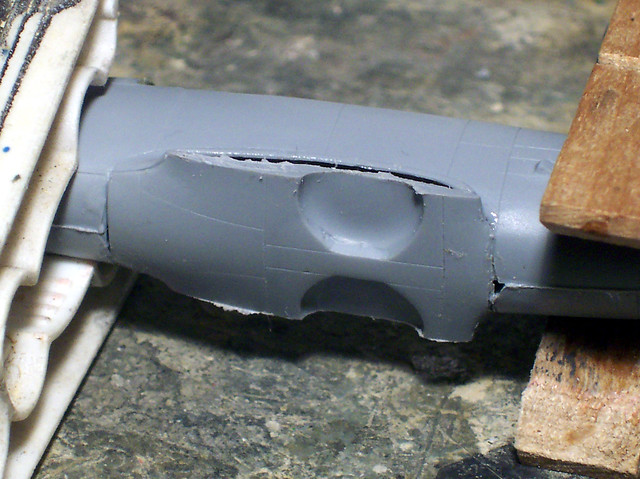

Mit den Flügeln am Platz wurde nun auch der Rumpf um ca. 5mm verlängert, um die Proportionen beizubehalten. Die Kühler in den Flanken sind geblieben, wie sie sind, wie auch das Seitenleitwerk, das groß genug war. Allerdings mussten neue Höhenruder her - dies sind stark zurechtgeschnitzte Spenderteile einer Brewster Buffalo (Matchbox). Hinzu kamen noch Ölkühler unterm Rumpf, eine neue Aufnahme für den Propeller (original) und abgesägte Kanülen für die Kanonen.

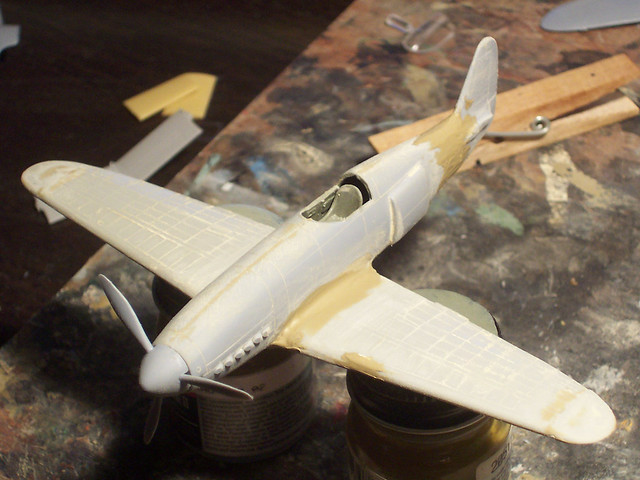
Der Anstrich orientiert sich an einer echten Ki-84 I aus der Fachliteratur: von oben in einem hellen, verwitterten Khaki, von unten Grüngrau (IJA-Grau?) und mit weißen Markierungen an Tragflächen und Finne.
Für die verwitterte Optik wurde das Modell zunächst mit Acryl-Alu grundiert und dann mit Khaki Drab (FS 34087) unregelmäßig übermalt. Leichtes Nassschleifen, eine Tuschewashing und Trockenbemalung/Shading z. B. mit Ocker hellte den Grundton auf. Von unten bildete Humbrol 90 (Beieggrün/Sky Type S) die Basis.
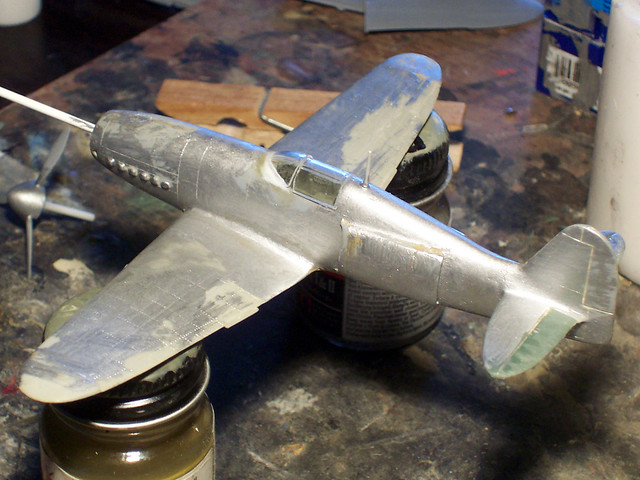
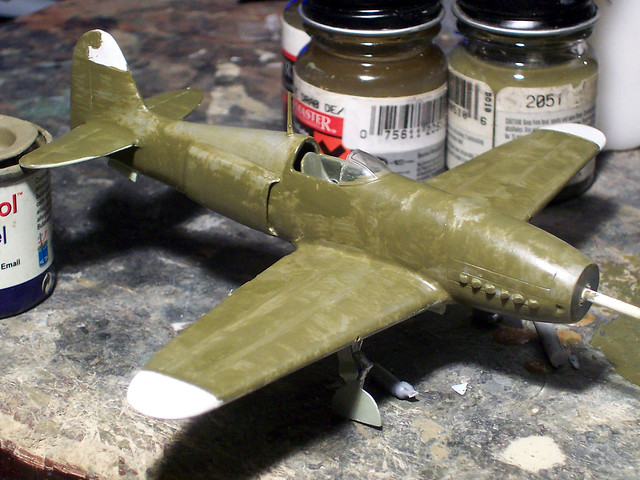
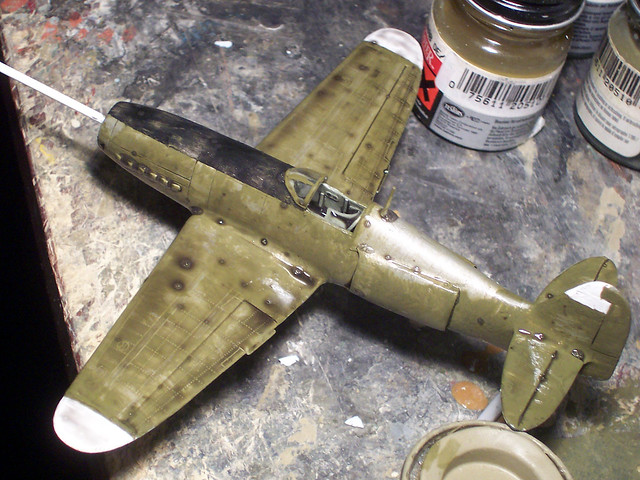
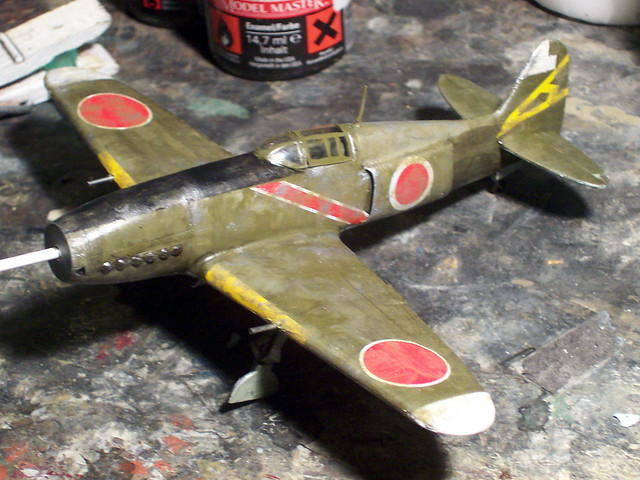
Decals sind aus verschiedenen Quellen zusammengepuzzelt, u.a. von einem Ki-27 Aftermarket-Sheet.
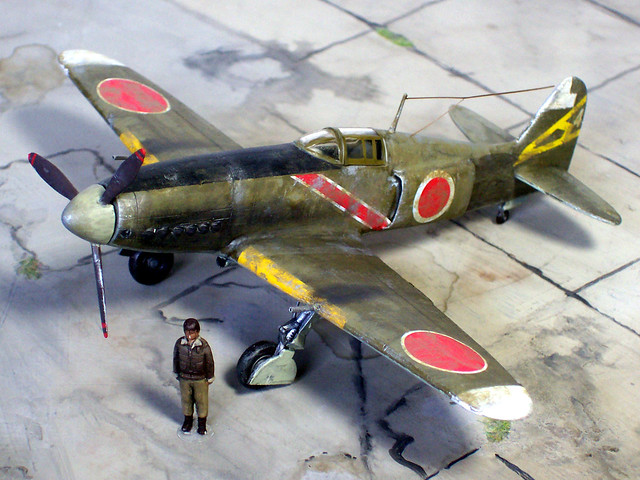
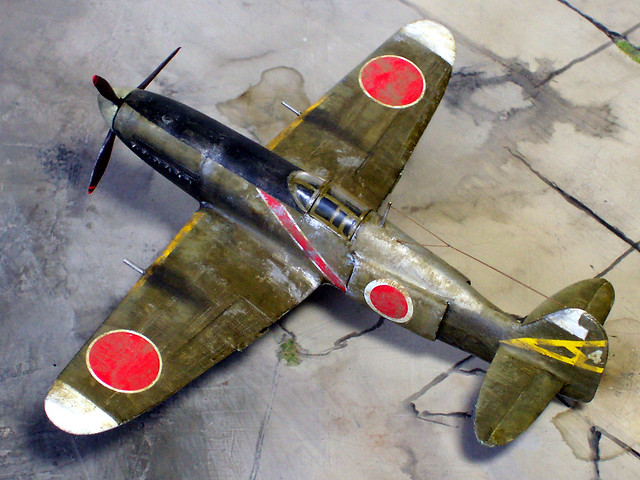

(Immer noch) Klein, aber gut geworden.
